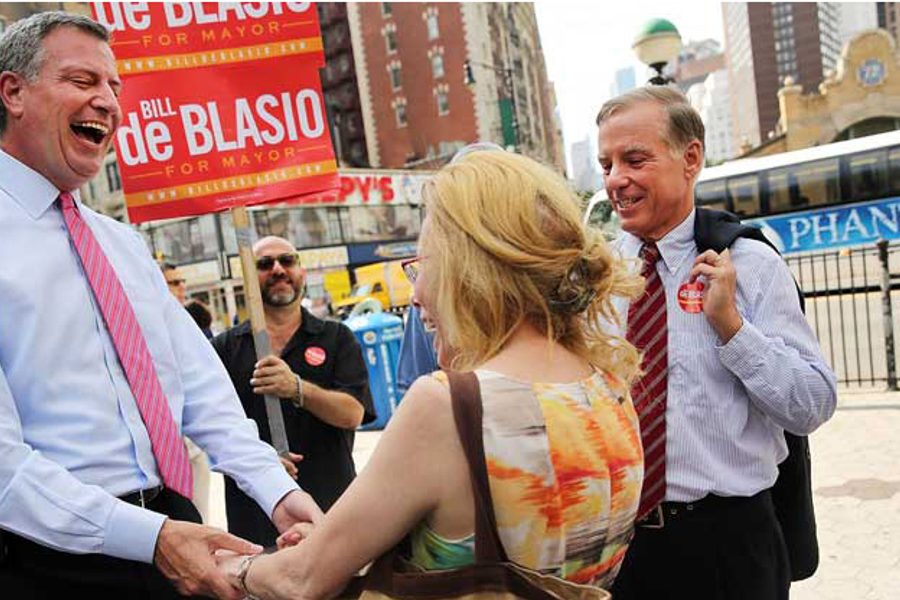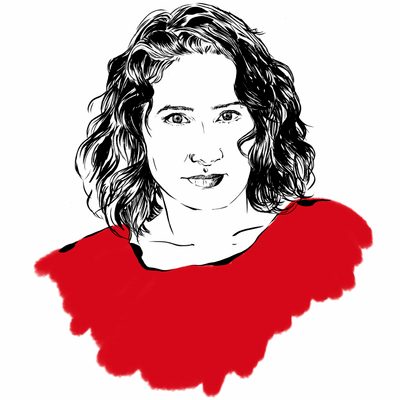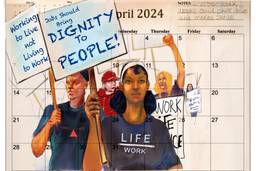Bill de Blasio’s Vision For A More Equal New York
The mayoral hopeful talks about his plan to close the ever-widening gulf between the city’s haves and have-nots.
Sarah Jaffe

When Bill de Blasio began his campaign for mayor of New York City early this year, he set out to run an economic populist campaign based on a narrative that echoed John Edwards’ leftward turn in 2008. De Blasio, who currently serves as the city’s Public Advocate, called that narrative “a tale of two cities,” and spoke of low-wage workers and unaffordable housing, of disappearing hospitals and a lack of child care, and of aggressive policing that targets the city’s black and Latino communities for constant harassment. This approach helped de Blasio snag the endorsements of the historically leftist 1199 SEIU healthcare workers union and of New York Communities for Change, the community group that kicked off the now-nationwide fast-food workers’ movement. But his poll numbers hovered at the lower end of the field.
All that has changed. Recent polls show him in second or even first place in a crowded field, and he’s been lauded by Salon.com and earned a rare endorsement from The Nation. At a rally on Friday, de Blasio accepted the first-ever mayoral endorsement of the New York State Nurses Association and unveiled a plan to make New York the first city in the country to provide paid family leave to new parents or people caring for a seriously ill family member. De Blasio’s surge to the front of the pack may have coincided with the spectacular collapse of Anthony Weiner’s campaign, but it also suggests that his message resonates with New Yorkers. That message, as well as his constant appearances at worker events and strike sites and his arrest in protest of hospital closures, have quietly made him the candidate of choice for the crowd who sees City Council Speaker Christine Quinn, long considered the frontrunner, as too close to New York’s divisive current mayor, billionaire Michael Bloomberg. After twelve years of Bloomberg, whose wealth has only gone up while most New Yorkers struggle to get by, it’s refreshing to see a candidate find success by deliberately highlighting his differences with the mayor.
The New York City Democratic primary will be held on September 10. If none of the candidates receives 40 percent of the vote (which seems likely, as Quinn, de Blasio, and former comptroller Bill Thompson are close in the polls), a runoff between the top two vote-getters will be held on October 1.
I’ve been running into de Blasio on picket lines and at hospital protests for months, and on Friday, I got the chance to speak with him about reforming the NYPD, universal pre-kindergarten, the fight to save the city’s hospitals, and more.
On Thursday, the City Council overrode Bloomberg’s veto of the Community Safety Act, the sweeping NYPD reforms that include the establishment of an inspector general and an expanded ban on racial profiling. You’ve been a supporter of the Community Safety Act, and you’ve also spoken about the effect that stop-and-frisk would have on your own son, who is biracial. I’ve heard less from your campaign about some other controversial NYPD practices, such as the surveillance of Muslim communities, and the use of condoms as evidence of prostitution during stops, often of women of color and transgender women. What would you do to change the NYPD on these issues, as well as on stop-and-frisk?
I believe in the state legislation that would end the practice of police using the presence of condoms as evidence that prostitution is taking place. I think that is, to say the least, a misguided and contradictory policy.
On surveillance, I think that finally having an independent inspector general is going to change everything. I think the crucial point now is naming the right inspector general and empowering [them] to really provide independent oversight, to be a strong public presence and check-and-balance. I think that will help ensure all police procedures are being done appropriately and constitutionally.
I think the bigger point here is that the Democrats have real disagreements on the issue of policing. I don’t think you can achieve fundamental reform by keeping the same leader in place, the man who has led the NYPD longer than anyone else in history, [Commissioner] Ray Kelly. I don’t think you can make fundamental change at the NYPD without embracing the notion of a truly independent inspector general and a local racial profiling ban. The pieces of legislation have passed, but they still have to be implemented in a meaningful way, and it matters who’s mayor and it matters who they’d use as commissioner. I am the only Democrat who’s said consistently [that] we need to do all three — we need a new police commissioner, we need a strong and independent inspector general, and a racial profiling ban — and they all have to be used together to reform a situation that really deepened over many years.
You were involved in the fight for paid sick days and the living-wage and prevailing-wage bills, all of which were watered down in the City Council (and prevailing wage overturned by a judge), and you’ve been supportive of campaigns like the fast-food strikes and the organizing drive at JFK Airport. What are some concrete steps that you would take as mayor to raise the wages of and improve working conditions for the city’s low-wage workers?
I think we have to act on a number of fronts simultaneously.
I want to get a fuller paid sick-days bill passed right away, one that includes the hundreds of thousands of people that were left out of the previous bill. I’d fight for an expansive use of living wage and work to win that legal case, but beyond that, I’d start innovating new ways to use city legislative power.
In California, there are extraordinary examples of legislation that expands the power of local government to make sure that any dealings they have with the private sector result in stronger agreements, where the private sector provides the jobs and the wage levels that have been agreed upon and there are real consequences if they don’t follow through. There are clawback provisions and provisions that inhibit other business dealings with the government unless deals are kept. That kind of approach is needed in New York.
I’d take a more forceful approach [in] aiding organizing efforts like the fast-food workers. I think [we need to] reprogram subsidies away from big companies and to small business loans and to the City University of New York system so more people can get trained for good jobs that exist. There are a lot of pieces to the puzzle, but I always say that if you start to combine a number of these approaches, all of which are available to us, it adds up to something that affects, ultimately, hundreds of thousands of families and will really make a difference in terms of fighting income inequality.
You’ve made early childhood education a key part of your campaign, and called for an expansion of after-school programs and for funding for universal, full-day pre-K. Tell us more about your plan — how will it be funded and what will it do? I know there’s been a critique from State Senator Diane Savino [a Thompson supporter] that this is state policy and that there’s not much the mayor can do about it.
The bottom line here is that we are failing when it comes to early childhood education. We’ve got 70,000 kids a year who are the right age for pre-K. About 20,000 now get full-day pre-K; almost 50,000 get something less — either half-day, or none. There are 50,000 kids from all walks of life in this city that we could be doing a lot better by, and, particularly for the disadvantaged kids among them, it could be a huge difference-maker.
[NewYorker.com] this week has a good piece explaining in great detail why my plan is both accurate and effective and realistic. We have the power to tax. We need Albany’s approval, but, historically, Albany approves when the mayor and City Council agree on something, and I think we’ll have strong agreement on this.
There’s no way to achieve full-day pre-K and the after-school programs that are also part of my package without a tax on the wealthy. It’s almost half a billion dollars a year. It’s a serious new endeavor, and it requires a tax on the wealthy to do it. A modest tax on the wealthy would make a huge difference for kids.
You’ve called for a moratorium on school closings and charter school co-locations, and, along with the other candidates, for limits on standardized testing. We’re in a situation where teachers in New York State just faced a massive change to their evaluation process that will require more testing, and the city’s teachers union hasn’t had a contract in four years. Tell us how you’d fix K-12 education, and whether New York’s schools should stay under mayoral control.
I do believe in mayoral control, but I believe in a very different approach that is much more consultative with parents and communities, and is much more respectful of teachers. I’d like a chancellor who’s an educator, who believes in fixing and improving the relationship with parents, and in a positive relationship with the teachers and everyone else who does the work.
That alone would start to change things, but I would end the focus on high-stakes testing. There’s a legal requirement from the state and federal level, but we should only do that which we are required to do legally. We should use the standardized tests to the most minimal level possible, not for all the decisions that became central in the Bloomberg years, [such as] the grading of schools and the access to specialized schools. Everything went through a standardized test, and from my point of view that was a very misguided policy that needs to be unwound quickly. I think that in doing that, we’d also give teachers the opportunity to start teaching again, using their capacity and creativity in the process.
You’ve talked about affordable housing and mentioned in a debate that homeless services would be a department you wouldn’t cut. Many renters face the challenge of moving constantly as rents continue to rise. What are some of the steps you’d take to ensure that rent becomes and remains affordable, and to make sure no one’s sleeping on the street?
I have the support of Tenants PAC, which is the leading voice of tenants in the city, and I called for a rent freeze this year because we’re still in the throes of an economic crisis. People are not in a position to handle a rent increase, and it is the city government’s job to intervene in a situation like that. The rent decisions are made by a mayoral majority on the [NYC Rent] Guidelines board, and obviously the mayor wasn’t willing to intervene.
On top of that, the real issue is to create a substantial new supply of affordable housing. My plan is for 200,000 units over the next 10 years, and it requires the real estate industry to produce much more affordable housing. It will mandate the creation of affordable housing in exchange for the right to develop in some areas. That’s called mandatory inclusionary zoning, and it’s a necessary policy.
The fight to keep the city’s hospitals open has become a central focus of your campaign and brought you a lot of attention. To some degree, though, these problems happen at the state and even the national level. What could you do as mayor to ensure that communities have access to healthcare?
Of course a lot of the policy is on a national level — it really parallels the discussion of income inequality. It’s very easy for local officials to blow off a whole host of issues and say, “Oh, we wish we could help but those are national issues.”
I’m very moved by what [economist and Nobel laureate] Joseph Stiglitz said when he endorsed me earlier in the week. He made a very powerful point: In a situation where there’s national gridlock on a whole set of issues that matter, states and localities have to fill that space and be the innovators of progressive policy.
We lost twelve hospitals in the Bloomberg years. A mayor has a whole host of tools and the bully pulpit to affect the situation. Between the city and the state, there’s a lot of regulatory and budgetary power that could be utilized to help fix situations in hospitals or tide them over as we try to bring in more federal support.
I think the bottom line is [that] it is the city’s responsibility to have a vision for the future of healthcare that includes the number of hospitals we’re going to have, and to support the hospitals we have, even if we have to restructure some, to make sure there’s local healthcare available.
Hurricane Sandy has faded from most people’s thoughts, but the neighborhoods hit hardest are still recovering, and, in some cases, facing new hits. What’s happening with Sandy rebuilding money, and what more could be done to ensure smart, green and equitable rebuilding?
It’s a mixed bag in terms of the process post-Sandy. There are a lot of people who still have not gotten the benefits they deserve. It’s something my office has worked on a lot as Public Advocate. I don’t think there’s been enough focus on preparation for the future in terms of working with community groups and nonprofits and preparing together.
I think the mayor has had a good vision for where we go in terms of long-term preparation for a new climate reality. I’m obviously not someone who has trouble criticizing Bloomberg, but I give him a lot of credit for his broader sense of the future of the city’s environment and of sustainability, whether it’s been the original PlaNYC or his more recent vision for dealing with climate change.
There’s lot of work to be done, particularly in the Rockaways. We need to use this opportunity to provide some of the help that the Rockaways deserved many years ago, particularly for public housing residents, and we need to use some of that incoming federal money for the biggest multiplier effect — including creating jobs for people who live there in the recovery.
I’ll wrap it together with this: We have a chance to marry together the notion of environmental sustainability with the notion of economic sustainability. There’s an opportunity both because of federal money and beyond to create a very substantial number of new jobs, but we need to make sure those jobs get to people who’ve been left out of this economy. We need to make sure those jobs are living-wage jobs that help people get to the middle class. It’s a huge, exciting opportunity, it’s complicated, and it’s a transcendent moment that we have to take hold of and make the most of.
Sarah Jaffe is a writer and reporter living in New Orleans and on the road. She is the author of Work Won’t Love You Back: How Devotion To Our Jobs Keeps Us Exploited, Exhausted, and Alone; Necessary Trouble: Americans in Revolt, and her latest book is From the Ashes: Grief and Revolution in a World on Fire, all from Bold Type Books. Her journalism covers the politics of power, from the workplace to the streets, and her writing has been published in The Nation, The Washington Post, The Guardian, The New Republic, the New York Review of Books, and many other outlets. She is a columnist at The Progressive and In These Times. She also co-hosts the Belabored podcast, with Michelle Chen, covering today’s labor movement, and Heart Reacts, with Craig Gent, an advice podcast for the collapse of late capitalism. Sarah has been a waitress, a bicycle mechanic, and a social media consultant, cleaned up trash and scooped ice cream and explained Soviet communism to middle schoolers. Journalism pays better than some of these. You can follow her on Twitter @sarahljaffe.








